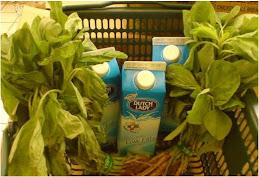For generations, the traditional dishes in many vegetarian Indian homes consist of a balanced diet. It includes a serving of dairy product like yogurt, yogurt milk or milk itself, two servings of vegetables which can be a vegetable curry or a dark leafy vegetable curry, with carbohydrates mostly from the rice and the chapatti and to end with something sweet for the taste buds.
MYTH STATING
" SHOULD NOT EAT SPINACH WITH MILK PRODUCTS"HOW TRUE IS IT?
The theory behind this myth is that the combination of calcium from milk and oxalic acid from the spinach forms calcium oxalate crystals that leads to blockage of the kidney or urinary tract. This means that this myth can also apply to all foods high in oxalic acid and calcium taken together such as the combination of spinach with bean curd or rhubarb with cheese.
SPINACHSpinach is a green leafy vegetable, said to be very nutritious for our body as it has many benefits to the body, contains Beta carotene, 13 types of
flavonoid, vitamin C which help in detoxification of the body hence reducing the free radicals in the body, prevent cancer and the build up of cholesterol on the inner blood vessels thus reducing the rate of cardiovascular disease ,Vitamin K helps in maintaining bone health,
folate helps the blood convert a potentially dangerous chemical called
homocysteine that can lead to heart attack or stroke if levels get too high, magnesium in the other hand helps in lowering blood pressure against
cardio vascular diseases and also acts as a co factor for many hormones, the beta- carotene, vitamin C and Vitamin K all have anti inflammatory properties hence help with conditions in which inflammation plays a role such as asthma, osteoarthritis, osteoporosis, rheumatoid arthritis and gout.
Spinach is rich in calcium also but it is not all well absorbed into the body therefore this is called one of the “negatives” for dark green leafy vegetables. Spinach contains an anti nutrient called oxalic acid that binds to calcium, preventing 95% of calcium absorption into the body; hence only 5% of the calcium in the spinach is absorbed in the body.
OXALIC ACID A naturally occurring chemical which is a dangerous poison at a high concentration but these levels are not found in food stuff, rather in manufactured products such as bleaches, anti-rusting products e.t.c
It is found in green leafy vegetables also, when this acid is processed in
the body it

combines with other substances such as calcium to form salts or
oxalates in this case calcium oxalate which if at a higher concentration can precipitate out in crystalline form. These tiny crystals of salts can irritate the human tissues especially the stomach, the kidneys and the blad
ders, con
tributing to the formation of kidney and bladder stones. This is not an instant effect but can happen in the long run, over a period of few years. The oxalic acid in the food stuff can vary substantially depending on their growth environment (e.g. plants with a lot of ammonia available to them when growing has substantially lower oxalic acid contents). It also depends on how the food is prepared i.e. boiled spinach has 0.65% of oxalic acid where as frozen spinach has 0.75% hence that shows a 25% increase of oxalic acid.
MILK
Milk is known to be as the most complete food of the world, it contains water, milk proteins, minerals, enzymes, gases such as oxygen and nitrogen and other vitamins like vitamin A, C, D, Thiamine, riboflavin e.t.c. calcium being the second abundant mineral in milk. one liter provides about 1100mg- 1300mg of calcium.
CALCIUM
The most abundant mineral found in the human body is calcium. Majority (99%) of it is stored in the bones and teeth while the rest is used and circulated between the muscle tissue and blood. The main purpose of calcium is bone building and remodeling, muscle contraction, central nervous function and hormone secretion. shirt term dietary deficiency of calcium is very rare as body can always used the stored calcium in the bones. Even toxicity of calcium is uncommon as the gastrointestinal tract normally limits the amount of calcium absorbed. So a short-term intake of large amounts of calcium may only produce constipation and an increased risk of kidney stones.
KIDNEY STONES
Kidney stones are formed from crystals in the urinary tract that separate from the urine and form a hard mass. If the crystals are tiny, they can pass out of the body without being noticed. If the crystals are large, they cause excruciating pain as it blocks the passage of urine, a burning sensation during urination and bloody urine. Nausea and vomiting may also be experienced. kidney stones can be caused due to many factors such as can be due to genes, or due to a decrease in inhibitors which are found in the urine that prevent kidney stones or due to some disorders and diseases or the presence of a crystal that promotes the crystallization of another species e.t.c.
So do you think that this myth stating that eating spinach with milk is not good for health as it can cause kidney stones in our body??
From all the above, it is common to assume that eating spinach (or other high oxalic acid foods) with milk (or other high calcium foods) will cause kidney stones in the long run. This assumption and myth however, is not true. In fact, it is the opposite of it. Dietary oxalate plays a very important role in the formation of calcium oxalate stones. But taking high calcium foods with high oxalic acid foods actually decreases the risk of kidney stone formation.
Many experiments were conducted some on rats and other on humans all the results conclude that the myth is not true as the authors concluded that urinary oxalate is more important than urinary calcium in the formation of stones. Calcium actually has a protective effect by binding to oxalate and phosphorus in the gut, preventing its absorption and lowering both urinary oxalate and urinary phosphorous that can contribute to the formation of kidney stones.
These crystals formed in the intestines will be carried by fiber and other unwanted masses to be discarded as feces. On the other hand when calcium intake is low, more oxalate can be absorbed into the body, leading to higher urinary excretion of
oxalates, which can bind with the normal urinary calcium and precipitate to from kidney stones. Thus, the consumption of high calcium foods together with high oxalic acid foods can lower the chances of kidney stone formation, whereas intake of high oxalic acid foods with a generally low-calcium diet increases the risk of kidney stones. only if the dietary calcium was less then normally needed, there will not be enough calcium absorbed as it may be combines with the oxalate in the gut
bt When calcium intake is moderate to high, while some are being combined to oxalic acid and lost, an adequate amount is still absorbed for the body. To avoid calcium toxicity, the upper tolerable level of intake per day is 2500mg.
As a conclusion, the best way to prevent kidney stones and maintain healthy bones is to consume adequate calcium from the diet and to fortify with supplements taken at mealtime if necessary. Calcium carbonate is an excellent choice as a supplement as it achieves maximum solubility in acidic environment (in the stomach) and thus, maximum absorption when taken with meals. It is also the most widely used supplement, moderately priced and contains the highest amount of elemental calcium of all supplements. For people at high risk of stones, an adequate calcium intake can be combined with restriction of oxalate-rich foods and phosphate-based sodas in people at risk for stones. Most essentially, a high fluid intake should be maintained at all times to avoid dehydration.
REFERENCE:
About.com: Health Topics A-Z, © 2009.Kidney Stones [Online] Available from: http://adam.about.com/reports/000081_2.htm [Accessed on 25th June 2009]
Alexa P., 2008. Spinach can be delicious as well as nutritious. Alexa P. demystifies this slightly intimidating vegetable with delicious recipes and tips to getting the most out of your greens, Fried Chillies.com [Online] Available from: http://www.friedchillies.com/index.php/articles/detail/the-wonders-of-spinach/ [Accessed on 25th June 2009]
Donna Staton Marcus Harding, © 2008. Calcium – Deficiency and toxicity, Requirements and supplementation [Online] Available from: http://www.faqs.org/nutrition/Ca-De/Calcium.html [Accessed on 7th June 2009]
Environmental Health & Safety, 2008. OXALIC ACID, Material Safety Data Sheet, Mallinckrodt Baker, Inc [Online] Available from: http://www.jtbaker.com/msds/englishhtml/o6044.htm [Accessed on 25th June 2009]
GlaxoSmithKline, © 2009. Kidney Stones, CalciumInfo.com [Online] Available from: http://www.calciuminfo.com/calciumquestions/kidneystones.aspx [Accessed on 25th June 2009]
Helen Signy, 2009. Let’s Talk Milk, The Evidence Behind the Health Claims. Life Well Shared, Reader’s Digest, June 2009 Edition. Pgs 98-103.
Hossain RZ, Ogawa Y, Morozumi M, Hokama S, Sugaya K. Milk and calcium prevent gastrointestinal absorption and urinary excretion of oxalate in rats, PubMed [Online] Available from: http://www.ncbi.nlm.nih.gov/pubmed/12700095 [Accessed on 25th June 2009]
Laurine Graff. A Handbook of Routine Urinalysis (book preview) pgs 89-90 [Online] Available from: http://books.google.com.my/books?id=qsEB5Sg-LkoC&pg=PA90&lpg=PA90&dq=amorphous+urates&source=bl&ots=vw8WPD4vvt&sig=nz6LKh42SJHDG5ZiHDH-8uHU0A0&hl=en&ei=jx49Sqf0MtKHkQXY6NDEDg&sa=X&oi=book_result&ct=result&resnum=3 [Accessed on 20th June 2009]
National Kidney and Urologic Diseases Information Clearinghouse, 2007. Kidney Stones in Adults, National Institute of Diabetes and Digestive and Kidney Diseases, National Institutes of Health [Online] Available from: http://kidney.niddk.nih.gov/Kudiseases/pubs/stonesadults/ [Accessed on 25th June 2009]
Richard Dion, 1997. About Crystals [Online] Available from: http://www.agora.crosemont.qc.ca/urinesediments/doceng/doc_024.htm#Intéret [Accessed on 25th June 2009]
The George Mateljan Foundation, © 2001-2009. Spinach, World's Healthiest Foods [Online] Available from: http://www.whfoods.com/genpage.php?tname=foodspice&dbid=43 [Accessed on 25th June 2009]
The Owlcroft Company, ©2009. Oxalic Acid and Foods [Online] Available from: http://growingtaste.com/oxalicacid.shtml [Accessed on 25th June 2009]
University of Guelph. Dairy Chemistry and Physics, Dairy Science and Technology [Online] Available from: http://www.foodsci.uoguelph.ca/dairyedu/chem.html#protein1. [Accessed on 6th June 2009]
University of Arizona. Calcium Supplement Guidelines, The University of Arizona, Cooperative Extension [Online] Available from: http://ag.arizona.edu/pubs/health/az1042.pdf [Accessed on 25th June 2009]
picture of calcium oxalate crystals [Online] Available from: http://www.udel.edu/medtech/mclane/uricpluscaoxagain400croparrow.jpg






